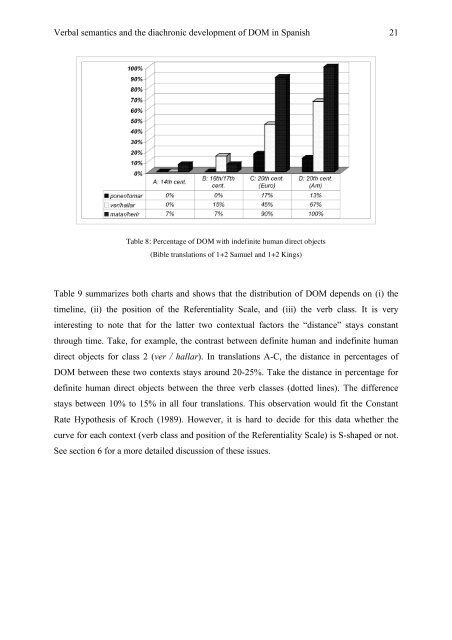Verbal Semantics and the Diachronic Development of Differential ...
Verbal Semantics and the Diachronic Development of Differential ...
Verbal Semantics and the Diachronic Development of Differential ...
You also want an ePaper? Increase the reach of your titles
YUMPU automatically turns print PDFs into web optimized ePapers that Google loves.
<strong>Verbal</strong> semantics <strong>and</strong> <strong>the</strong> diachronic development <strong>of</strong> DOM in Spanish 21<br />
Table 8: Percentage <strong>of</strong> DOM with indefinite human direct objects<br />
(Bible translations <strong>of</strong> 1+2 Samuel <strong>and</strong> 1+2 Kings)<br />
Table 9 summarizes both charts <strong>and</strong> shows that <strong>the</strong> distribution <strong>of</strong> DOM depends on (i) <strong>the</strong><br />
timeline, (ii) <strong>the</strong> position <strong>of</strong> <strong>the</strong> Referentiality Scale, <strong>and</strong> (iii) <strong>the</strong> verb class. It is very<br />
interesting to note that for <strong>the</strong> latter two contextual factors <strong>the</strong> “distance” stays constant<br />
through time. Take, for example, <strong>the</strong> contrast between definite human <strong>and</strong> indefinite human<br />
direct objects for class 2 (ver / hallar). In translations A-C, <strong>the</strong> distance in percentages <strong>of</strong><br />
DOM between <strong>the</strong>se two contexts stays around 20-25%. Take <strong>the</strong> distance in percentage for<br />
definite human direct objects between <strong>the</strong> three verb classes (dotted lines). The difference<br />
stays between 10% to 15% in all four translations. This observation would fit <strong>the</strong> Constant<br />
Rate Hypo<strong>the</strong>sis <strong>of</strong> Kroch (1989). However, it is hard to decide for this data whe<strong>the</strong>r <strong>the</strong><br />
curve for each context (verb class <strong>and</strong> position <strong>of</strong> <strong>the</strong> Referentiality Scale) is S-shaped or not.<br />
See section 6 for a more detailed discussion <strong>of</strong> <strong>the</strong>se issues.

















